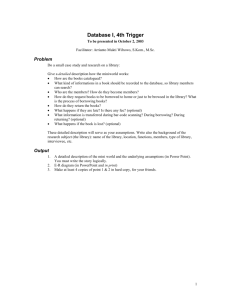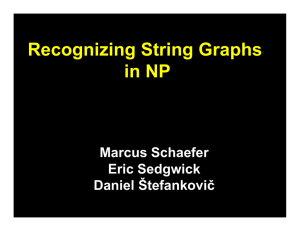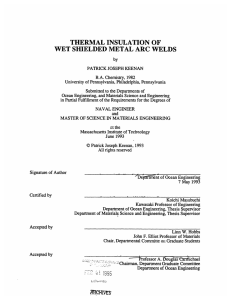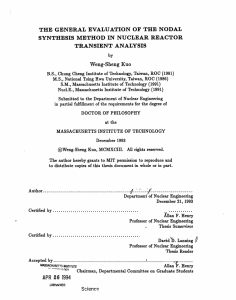New PARCS Cross Section Model
advertisement
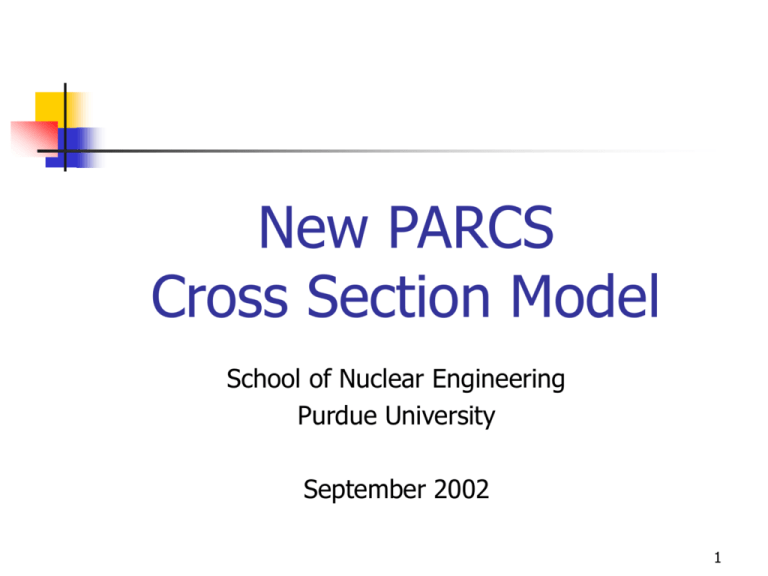
New PARCS Cross Section Model School of Nuclear Engineering Purdue University September 2002 1 Original XS Model in PARCS (1997) 2 2 ( , Tf , Tm, Dm, Sb) Tf Tm Dm Sb Dm Tm Dm Sb Dm 2 Tf r cr r: XS at unroded reference state cr: Control rod XS; Tf: Fuel temperature; : roded fraction; Tm: moderator temperature Sb: Soluble Boron Density; Dm: moderator Density At most seven cross section data points can be referenced 1 reference state 2 moderator branches 1 branches for each of other variables: Cr, Tf,Tm,Sb 2 Example of Original Model comp_num 3 !corner reflector !-----------------------------------------------------------------------------base_macro 2.956090e-01 1.187820e-03 0.000000e+00 0.000000e+00 2.008080e-02 2.459310e+00 2.526180e-01 0.000000e+00 0.000000e+00 dxs_dppm 0.000000e+00 0.000000e+00 0.000000e+00 0.000000e+00 0.000000e+00 7.761840e-04 8.446950e-05 0.000000e+00 0.000000e+00 comp_num 4 !fuel 1 !-----------------------------------------------------------------------------base_macro 2.221170e-01 8.717740e-03 4.982770e-03 6.111896e-14 1.824980e-02 8.031400e-01 6.525500e-02 8.390260e-02 1.101520e-12 dxs_dppm 3.478090e-08 1.285050e-07 -1.120990e-09 -1.761878e-20 -1.085900e-07 -9.765100e-06 7.088070e-06 -2.430450e-06 -3.190845e-17 dxs_dtm -2.033100e-06 2.121910e-07 1.247090e-07 1.430354e-18 8.096760e-07 -1.086740e-04 -3.155970e-05 -4.164390e-05 -5.467221e-16 dxs_ddm 1.356650e-01 1.551850e-03 9.206940e-04 1.023919e-14 2.931950e-02 9.926280e-01 2.526620e-02 2.477460e-02 3.252554e-13 dxs_dtf -3.091970e-05 3.497090e-05 6.401340e-07 7.154124e-18 -2.755360e-05 -1.372920e-04 -3.718060e-05 -5.630370e-05 -7.391879e-16 cdf 1.0069 0.9307 1.0034 0.9646 1.1040 1.4493 1.0096 1.1580 delcr_comp 1 1 -5 7 -11 !compostions that this set applies !-----------------------------------------------------------------------------delcr_base 3.732200e-03 2.477700e-03 -1.027860e-04 -1.214480e-15 -3.192530e-03 -2.199260e-02 2.558750e-02 -2.823190e-03 -3.702378e-14 3 Applications of Original Model: Static and Spatial Kinetics Problems Eigenvalue Benchmark Problems IAEA3D, L336, … OECD NEACRP Rod Eject Benchmarks Coupled Code Problems OECD TMI MSLB OECD Peach Bottom Turbine Trip Problems with Oconnee Control Rod Drive Cracking (CASMO Tables format) 4 Depletion Capability Added (2000) Nuclide depletion equation (Bateman) Absorb netron B β dN A (t ) ( Aa A ) N A (t ) C N c (t ) B N B (t ) dt A β n,γ C Neutron Transport Equation (Boltzmann) 1 1 (r , E , , t ) t (r , E ) (r , E , , t ) S f (r , E , t ) v t 4 s (r , E ' E , ' ) (r , E ' , ' , t )dE ' d' ' E ' 5 Depletion XS Model 2 2 ( , Tf , Tm, Dm, Sb) Tf Tm Dm Sb Dm Tm Dm Sb Dm 2 Tf r cr ( Tf , BU , HIS 1, HIS 2) Tf Tf ( Sb, BU , HIS 1, HIS 2) Sb Sb (Tm, BU , HIS 1, HIS 2) Tm Tm ( Dm, BU , HIS 1, HIS 2) Dm Dm 2 2 ( Dm, BU , HIS 1, HIS 2) Dm 2 Dm 2 cr cr ( BU , HIS 1, HIS 2) Burnup and burnup “history” dependence More than seven data points can be referenced 6 U.S. NRC Coupled Code Analysis Lattice Code (HELIOS/NEWT) Neutron Flux Solver (PARCS) Σ Cross Section Library (PMAX) T/H code (RELAP /TRAC) Φ Depletion Code (DEPLETOR) 7 Application of Depletion Model DOE NERI Projects: SBWR design HCBWR Design Iteration required between PARCS and Depletor … computationally inefficient Not able to handle generalized cross section tables 8 Standard “Two Step” Procedure for Generating LWR Cross Sections Lattice Calculations Neutronics Calculation Output files XS of each region XS library generator XS interpreter Cross section library 9 First Step of in NRC Neutronic Code System Lattice Codes: SCALE HELIOS …. Input files for depletion at various base states and branches at some burnup points Output files GenpXS PMAXS 10 Base State and Branches Performed with Lattice Physics Code Branches Base state 0GWD/T Fuel temp. mod temp. Mod. den. Soluble B. Control Tf1, Tf2… Tm1, Tm2… Dm1, Dm2… ppm1, … rod … Fuel temp. mod temp. Mod. den. Soluble B. Control Tf1, Tf2… Tm1, Tm2… Dm1, Dm2… ppm1, … rod … 1GWD/T 2GWD/T 3GWD/T 4GWD/T 5GWD/T 11 Cross Section Library in NRC Neutronic Code System Dependent Variables: Principle Cross Sections : a , f , f , tr , g g ' , ADF , CDF ... Delay Neuton parameters : , Decay Heat parameters : H , H Xenon & Samarium Cross Sections : aXe , aSm , YI , YXe , YPm , YSm , I , IXe , Pm Local Peaking Factors : f Power , J1 ( for MCPR calculatio n) Detector information : form functions, multiplier s 2 D Form Functions : flux, power ....... PMAXS Independent Variables: Instantaneous variables : Cr , Md , Sb, Tf , Tm History variables : Other variables : HCr , HMd , HSb , HTf , HTm Lattice ID , Neutron enegy group , Delay Neutron Group, Decay Heat Group, Location for Local factor, Form function, etc 12 Second Step of in NRC Neutronic Code System T/H Code: PARCS XS Model: Interpret XS base on instantaneous variables XS of each region at given history value PMAXS Neutronic Calculation RELAP TRAC …. Power distribution Depletor 13 Format of PMAXS in Depletion Cross Section Model Appendix B. PMAXS format ---------------------------------------------------------------------- PMAXS (version 1.0, revision-01) ---------------------------------------------------------------------- Last revised 4/2/01 The Format of Purdue Macroscopic Cross Section (XS) Set ---------------------------------------------------------------------- File Data File identification Fuel Assembly wise data (repeat for all kinds of assemblies) Assembly identification Assembly control data Assembly Group independent data Assembly Energy bound information data Reference state data Identification of the base state Control data of the base state State data of the base state Principal cross sections of the base state Scattering cross sections of the base state Xe/Sm cross sections of the base state Soluble boron cross section of the base state Delayed neutron data of the base state Decay heat data of the base state Power form function of the base state Group-wise form function of the base state Detector information of the base state Soluble Boron branch case Identification Control data State data (repeat for all soluble boron branch case) Derivation of the principal cross sections Existence always always always LORD > 0 ISXE=1 ISSB = 1 NDFAM > 0 NDCAY > 0 IPFF = 1 IGFF=1 ISDE=1 IBSB > 0 14 Motivation for New PARCS Cross Section Model Old Model has limited accuracy and applicability for practical cross section data sets which are multi-dimensional tables (e.g. Ringhalls) New Model performs multi-dimensional interpolation to construct partial derivates This increases the range of applicability and yet preserves applicability of old PARCS XSEC files 15 Advantages of New Model If there are more than 2 points in a line, then New Model is actually quadratic interpolation. Can obtain good accuracy even with smaller number of branches 16 Ringhalls Stability Benchmark Ringhals XS in TABLES format ( EXP, HVO, HCR, VOI , TFU , CRD ) base ( EXP, HVO ) VOI ( EXP, HVO, VOI ) TFU ( EXP, VOI , TFU ) CRD ( EXP, VOI , CRD ) HCR ( EXP, CRD , HCR ) Multiple 3-Dimensional tables Multiple Control rod compositions 17 Application of New Model to Ringhalls ( , Dm, Sb, Tf , Tm) r ( Dm r , Sb r , Tf r , Tm r ) i i ( Dm r , Sb r , Tf r , Tm r ) i Dm Tf Sb Dm ( , Dm m , Sb r , Tf r , Tm r ) Sb ( , Dm , Sb m , Tf r , Tm r ) Tm m r Tf ( , Dm , Sb , Tf , Tm ) Tm ( , Dm , Sb , Tf , Tm m ) Tf Tf Tf r Tf m (Tf Tf r ) / 2 The partials will be obtained by piece wise linear interpolation If the XS at blue point are also available, New Model gives same XS as Model 2 better than Model 1 Other wise New Model gives same XS as Model 1 better than Model 2 18 Important to Choose Best Sequence to Evaluate Variables K Dm K DB K Tf Dm Very Strong Strong Strong Very Strong DB Strong Weak Normal Weak Normal Weak Very Strong Normal Almost no Almost no Almost no Strong Tf Tm K Tm Suggested sequence: Dm DB Tf Tm 19 Example: Moderator temperature and density Original Dm 1.0 0.96 0.9 Original Data point 0.94 0.8 0.92 0.7 0.9 0.6 0.88 Selected point 0.5 0.86 0.9 0.8 600 0.7 550 0.6 0.4 Density 0.4 500 0.5 0.3 450 0.3 Temperature (Tm, Dm) (Tm r , Dm r ) Tm 415 515 615 Tm Dm Tm (Tm m , Dm r ) Dm (Tm, Dm m ) 20 Effect of Different Sequence: Using Temperature then Density (Tm, Dm) (Tm r , Dm r ) Tm Dm Tm (Tm m , Dm r ) Dm (Tm, Dm m ) error of linear interpolation, rms=0.01202 linear interpolation 0.04 0.96 0.02 0.94 0.92 0 0.9 -0.02 0.88 -0.04 1 0.86 1 0.8 0.8 600 500 0.4 450 500 0.4 550 0.6 Density 600 550 0.6 Density 450 Temperature Temperature 21 Effect of Different Sequence: Using Density then Temperature ( Dm, Tm) ( Dm r , Tm r ) Dm Tm Dm ( Dm m , Tm r ) Tm ( Dm, Tm m ) linear interpolation error of linear interpolation, rms=0.00098 -3 x 10 0.96 2.5 2 0.94 1.5 0.92 1 0.5 0.9 0 -0.5 0.88 -1 0.86 -1.5 600 600 1 550 0.9 0.8 500 0.7 0.9 0.8 500 0.6 0.7 0.6 0.5 450 Temperature 1 550 0.5 450 0.4 0.3 Density Temperature 90% error reduced 0.4 0.3 Density 22 Tree structure of states at which XS/partials are calculated or stored Ref. CR calcul XS Dm1 Dm partials calcul XS SB partials Tf1 Tfr Tf1m calcul XS Tf2 Tf2m Tmr Tm1 Sbr 1: no Dmr Sbr Tfr Tmr Tf partials Tm partials Dm1m Dmr Dm2 Dm3 calcul XS Dm2m Dm3m Sb1 Sb1m Sb2 Sb2m Tm1m Sbr Tm2 Tmr Tm3 2:SS Tm2m Tm3m Sbr 3:B4C XS at reference states Calculate & Store Sb3 Sb3m XS calculate Tfr Tf3 Tf3m XS already calculated Partials store 23 New PMAXS/XSEC Format 1 Branches information XS Set wise data 2 XS Set identification 3 Dimension data 4 Burnup and Restart information History case wise data (repeat for each history case) 5 History case identification Reference state data 6 State identification XS Data Block (repeat for each burnup point) 7 Burnup point identification 8 Principal cross sections 9 Scattering cross sections 10 ADF 11 CDF 12 Local Power Peaking Factors 13 Power form function 14 Group-wise form function 15 Detector information 16 Xe/Sm cross sections 17 Delayed neutron data 18 Decay heat data 19 End Label of XS Block Existence NBRA>1 Always Always Always NEXP>1 Always Always Always Always Always NBURN>1 Always Always Optional Optional Optional Optional Optional Optional Optional Optional Optional Always Control rod branch cases (same structure with Ref. state case) Moderator density branch cases (same structure) Soluble Boron branch cases (same structure) Fuel temperature branch cases (same structure) IBCR>0 IBMD>0 IBSB > 0 IBTF>0 Moderator temperature branch cases (same structure) IBTM >0 *The data in XS Block are original data for reference state, data difference for CR branch case, and partials for other branches 1 Branches information (repeat for all type of branches structures) XS Set wise data 2 XS Set identification 3 Dimension data Reference state data 6 State identification XS Block 8 Principal cross sections 9 Scattering cross sections 10 ADF 11 CDF 12 Local Power Peaking Factors 13 Power form function 14 Group-wise form function 15 Detector information 16 Xe/Sm cross sections 17 Delayed neutron data 18 Decay heat data 19 End Label of XS Block Existence NBRA>1 Always Always Always Always Always Always Always Always Optional Optional Optional Optional Optional Optional Optional Optional Optional Always Control rod branch cases (same structure with Ref. state case) Moderator density branch cases (same structure) Soluble Boron branch cases (same structure) Fuel temperature branch cases (same structure) IBCR>0 IBMD>0 IBSB > 0 IBTF>0 Moderator temperature branch cases (same structure) IBTM >0 *The data in XS Block are original data for reference state, data difference for CR branch case, and partials for other branches 24 New Model Successfully Applied to Previous TRACM/PARCS Benchmarks OECD MSLB & PBTT Benchmarks: NEMTAB format * NEM-Cross Section Table Input * * T Fuel Rho Mod. Boron ppm. T Mod. 5 6 0 0 * ******* X-Section set # 1 1 * * Group No. 1 * *************** Diffusion Coefficient Table * .5000000E+03 .7602200E+03 .8672700E+03 .9218800E+03 .6413994E+03 .7114275E+03 .7694675E+03 .7724436E+03 .8100986E+03 .1467049E+01 .1469641E+01 .1470751E+01 .1477128E+01 .1401975E+01 .1404351E+01 .1405441E+01 .1411216E+01 .1353822E+01 .1356107E+01 .1357086E+01 .1362596E+01 .1352366E+01 .1354638E+01 .1355630E+01 .1361236E+01 .1345620E+01 .1347891E+01 .1348843E+01 .1354390E+01 .1322122E+01 .1324319E+01 .1325308E+01 .1330615E+01 * *************** Total Absorption X-Section Table .1500000E+04 .7813064E+03 .1471347E+01 .1405939E+01 .1357581E+01 .1356125E+01 .1349338E+01 .1325803E+01 25 Application of New XSEC Model to OECD Ringhalls Instability Benchmark Axial Power Distribution (HZP) 3.5 PARCS-ENTRÉE XS-NoADF Keff = 1.11430 3 Relative Power 2.5 PARCS-PMAXS-ADF Keff = 1.11400 2 ENTRÉE-ADF keff=1.11508 PARCS-PMAXS-No ADF Keff = 1.11465 1.5 ENTRÉE -No ADF keff=1.11473 1 0.5 0 0 5 10 15 20 25 30 Axial level Entree No ADF Entree ADF PARCS-PMAXS-No ADF PARCS-PMAXS-ADF PARCS-ENTREE XS-No ADF 26 Continuing Cross Section Work Future work New interface between PARCS and Depletor (12/31/02) GENPXS to convert other lattice code cross sections to PMAXS(e.g. CASMO, ORNL SCALE/NEWT) (FY03) 27 Modifications of Cross Section Model for ESBWR Task 3: Modifications in Spatial Kinetics Feedback Task 3.1: Lattice Physics (Purdue) Improve cross section model in PARCS for ATRIUM-10 and GE-12/14 The cross section model in PARCS will be improved to provide feedback based on both bypass liquid temperature and channel internal fluid field. Concerning fuel temperature feedback, the cross section model will be updated to handle both full length and part length fuel rods. Perform lattice physics calculations The work on this subtask will be completed by November 28 30, 2002. Advanced BWR Fuel Design GE-12 Fuel Configuration 29 Advanced BWR Fuel Design ATRIUM-10 Framatome SVEA-96 (ABB) Westinghouse 1/3 part length full length 2/3 part length 30 Modifications for ESBWR (cont.) Task 3.2: Monte Carlo Studies (Purdue) A new energy partitioning algorithm will be developed for PARCS taking into account bypass water regions, water rod regions, intra-channel fluid regions, and fuel rods. A Monte Carlo calculation will be performed to validate this new algorithm. All results will be documented. The Monte Carlo study will be completed by December 31, 2002. 31 Modifications for ESBWR (cont.) Task 3.3/3.4: Modify Mapping / Test Spatial Kinetics Feedback (ISL) Modify Mapping to Accommodate new assembly cross section model To test the spatial kinetics feedback with a Browns Ferry full core model will be built and a sample steady-state and control rod move transient calculation will be performed. The spatial kinetics model feedback testing will be completed by February 28, 2003. 32 ESBWR Core Configuration 33


